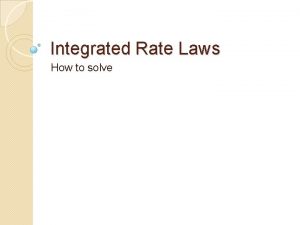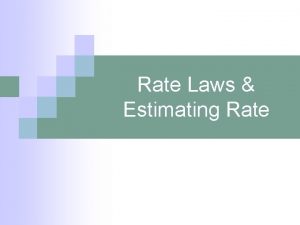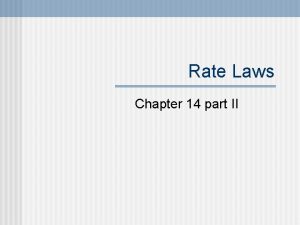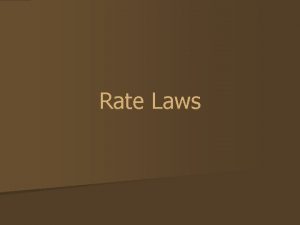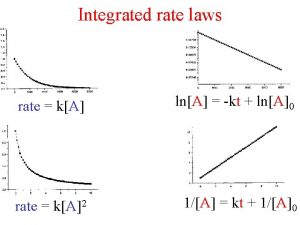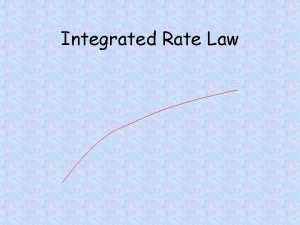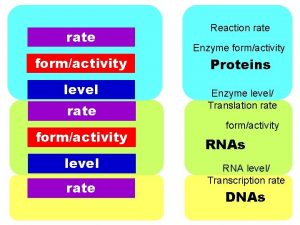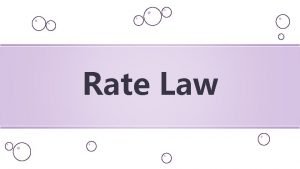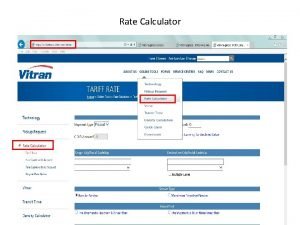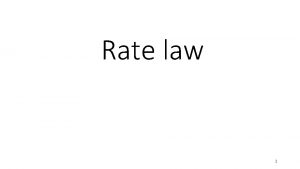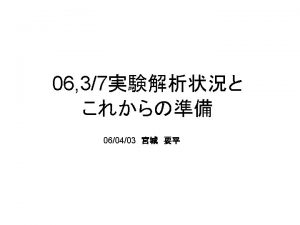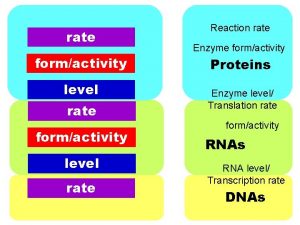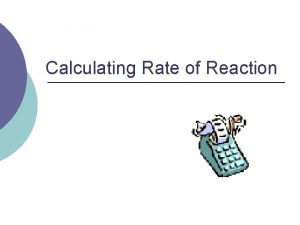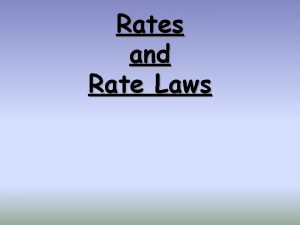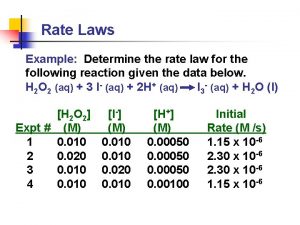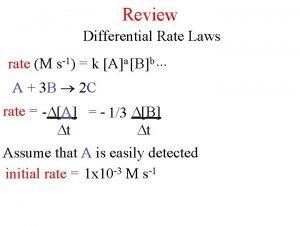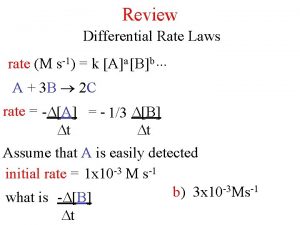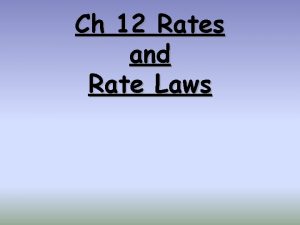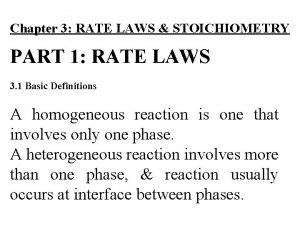AP Integrated Rate Laws Integrated Rate Laws For



![Zero Order Reactions • Rate = k[A]0 = k – Constant rate reactions • Zero Order Reactions • Rate = k[A]0 = k – Constant rate reactions •](https://slidetodoc.com/presentation_image_h/1121a0069bf0417d71ee644af55e9416/image-4.jpg)
![First Order Reactions • Rate = k[A]1 = k[A] • ln[A] = −kt + First Order Reactions • Rate = k[A]1 = k[A] • ln[A] = −kt +](https://slidetodoc.com/presentation_image_h/1121a0069bf0417d71ee644af55e9416/image-5.jpg)
![First-Order Integrated Rate Law ln[A]initial Slo ln[A] pe Time =− k First-Order Integrated Rate Law ln[A]initial Slo ln[A] pe Time =− k](https://slidetodoc.com/presentation_image_h/1121a0069bf0417d71ee644af55e9416/image-6.jpg)


![Second Order Reactions • Rate = k[A]2 • 1/[A] = kt + 1/[A]initial • Second Order Reactions • Rate = k[A]2 • 1/[A] = kt + 1/[A]initial •](https://slidetodoc.com/presentation_image_h/1121a0069bf0417d71ee644af55e9416/image-9.jpg)
![Second-Order Integrated Rate Law 1/[A] p o l S 1/[A]initial Time k = e Second-Order Integrated Rate Law 1/[A] p o l S 1/[A]initial Time k = e](https://slidetodoc.com/presentation_image_h/1121a0069bf0417d71ee644af55e9416/image-10.jpg)

![Graphical Determination of the Rate Law for A Product • Plots of [A] versus Graphical Determination of the Rate Law for A Product • Plots of [A] versus](https://slidetodoc.com/presentation_image_h/1121a0069bf0417d71ee644af55e9416/image-12.jpg)























- Slides: 35

AP Integrated Rate Laws

Integrated Rate Laws • For the reaction A products, the rate law depends on the concentration of A. • Applying calculus to integrate the rate law gives another equation showing the relationship between the concentration of A and the time of the reaction; this is called the integrated rate law.

Half-Life • The half-life, t 1/2, of a reaction is the length of time it takes for the concentration of the reactant to fall to ½ its initial value. • The half-life of the reaction depends on the order of the reaction.
![Zero Order Reactions Rate kA0 k Constant rate reactions Zero Order Reactions • Rate = k[A]0 = k – Constant rate reactions •](https://slidetodoc.com/presentation_image_h/1121a0069bf0417d71ee644af55e9416/image-4.jpg)
Zero Order Reactions • Rate = k[A]0 = k – Constant rate reactions • [A] = −kt + [A]initial • Graph of [A] versus time – straight line with slope = −k and y-intercept = [A]initial • t ½ = [Ainitial]/2 k • When Rate = M/sec, k = M/sec [A]initial [A] Slo pe Time =− k
![First Order Reactions Rate kA1 kA lnA kt First Order Reactions • Rate = k[A]1 = k[A] • ln[A] = −kt +](https://slidetodoc.com/presentation_image_h/1121a0069bf0417d71ee644af55e9416/image-5.jpg)
First Order Reactions • Rate = k[A]1 = k[A] • ln[A] = −kt + ln[A]initial • Graph ln[A] versus time – straight line with slope = −k and y-intercept = ln[A]initial – Used to determine the rate constant • t½ = 0. 693/k • The half-life of a first order reaction is constant. • When Rate = M/sec, k = s– 1
![FirstOrder Integrated Rate Law lnAinitial Slo lnA pe Time k First-Order Integrated Rate Law ln[A]initial Slo ln[A] pe Time =− k](https://slidetodoc.com/presentation_image_h/1121a0069bf0417d71ee644af55e9416/image-6.jpg)
First-Order Integrated Rate Law ln[A]initial Slo ln[A] pe Time =− k

The Half-Life of a First-Order Reaction Is Constant Insert Figure 13. 11

Rate Data for C 4 H 9 Cl + H 2 O ® C 4 H 9 OH + HCl
![Second Order Reactions Rate kA2 1A kt 1Ainitial Second Order Reactions • Rate = k[A]2 • 1/[A] = kt + 1/[A]initial •](https://slidetodoc.com/presentation_image_h/1121a0069bf0417d71ee644af55e9416/image-9.jpg)
Second Order Reactions • Rate = k[A]2 • 1/[A] = kt + 1/[A]initial • Graph 1/[A] versus time – straight line with slope = k and y-intercept = 1/[A]initial – Used to determine the rate constant • t½ = 1/(k[A 0]) • When Rate = M/sec, k = M− 1 · s− 1
![SecondOrder Integrated Rate Law 1A p o l S 1Ainitial Time k e Second-Order Integrated Rate Law 1/[A] p o l S 1/[A]initial Time k = e](https://slidetodoc.com/presentation_image_h/1121a0069bf0417d71ee644af55e9416/image-10.jpg)
Second-Order Integrated Rate Law 1/[A] p o l S 1/[A]initial Time k = e

Insert Table 13. 2
![Graphical Determination of the Rate Law for A Product Plots of A versus Graphical Determination of the Rate Law for A Product • Plots of [A] versus](https://slidetodoc.com/presentation_image_h/1121a0069bf0417d71ee644af55e9416/image-12.jpg)
Graphical Determination of the Rate Law for A Product • Plots of [A] versus time, ln[A] versus time, and 1/[A] versus time allow determination of whether a reaction is zero, first, or second order. • Whichever plot gives a straight line determines the order with respect to [A]. – If linear is [A] versus time, Rate = k[A]0. – If linear is ln[A] versus time, Rate = k[A]1. – If linear is 1/[A] versus time, Rate = k[A]2.




Relationship between Order and Half. Life • For a zero order reaction, the lower the initial concentration of the reactants, the shorter the half-life. – t 1/2 = [A]init/2 k • For a first order reaction, the half-life is independent of the concentration. – t 1/2 = ln(2)/k • For a second order reaction, the half-life is inversely proportional to the initial concentration, increasing the initial concentration shortens the half-life. – t 1/2 = 1/(k[A]init)

Example 13. 3 The First–Order Integrated Rate Law: Using Graphical Analysis of Reaction Data Consider the equation for the decomposition of SO 2 Cl 2: The concentration of SO 2 Cl was monitored at a fixed temperature as a function of time during the decomposition reaction, and the following data were tabulated: Show that the reaction is first order, and determine the rate constant for the reaction. Solution In order to show that the reaction is first order, prepare a graph of ln[SO 2 Cl 2] versus time as shown.

Example 13. 3 The First–Order Integrated Rate Law: Using Graphical Analysis of Reaction Data Continued The plot is linear, confirming that the reaction is indeed first order. To obtain the rate constant, fit the data to a line. The slope of the line will be equal to –k. Since the slope of the best fitting line (which is most easily determined on a graphing calculator or with spreadsheet software such as Microsoft Excel) is – 2. 90 × 10– 4 s– 1, the rate constant is therefore +2. 90 × 10– 4 s– 1. For Practice 13. 3 Use the graph and the best fitting line in Example 13. 3 to predict the concentration of SO 2 Cl 2 at 1900 s.

Example 13. 4 The First-Order Integrated Rate Law: Determining the Concentration of a Reactant at a Given Time In Example 13. 3 , you determined that the decomposition of SO 2 Cl 2 (under the given reaction conditions) is first order and has a rate constant of +2. 90 × 10– 4 s– 1. If the reaction is carried out at the same temperature, and the initial concentration of SO 2 Cl 2 is 0. 0225 M, what will the SO 2 Cl 2 concentration be after 865 s? Sort You are given the rate constant of a first-order reaction and the initial concentration of the reactant and asked to find the concentration at 865 seconds. Given: Find: Strategize Refer to the first-order integrated rate law to determine the information you are asked to find. Equation Solve Substitute the rate constant, the initial concentration, and the time into the integrated rate law. Solve the integrated rate law for the concentration of [SO 2 Cl 2]t.

Example 13. 4 The First-Order Integrated Rate Law: Determining the Concentration of a Reactant at a Given Time Continued Solution Check The concentration is smaller than the original concentration as expected. If the concentration were larger than the initial concentration, this would indicate a mistake in the signs of one of the quantities on the right-hand side of the equation. For Practice 13. 4 Cyclopropane rearranges to form propene in the gas phase. The reaction is first order in cyclopropane and has a measured rate constant of 3. 36 × 10– 5 s– 1 at 720 K. If the initial cyclopropane concentration is 0. 0445 M, what will the cyclopropane concentration be after 235. 0 minutes?

Problem: The decomposition of N 2 O 5(g) following 1 st order kinetics. If 2. 56 mg of N 2 O 5 is initially present in a container and 2. 50 mg remains after 4. 26 min, what is the rate constant in s 1? Begin with the integrated rate law for a 1 st order process: Wait… what is the volume of the container? ? ? Do we need to convert to moles?

Problem: The decomposition of N 2 O 5(g) following 1 st order kinetics. If 2. 56 mg of N 2 O 5 is initially present in a container and 2. 50 mg remains after 4. 26 min, what is the rate constant in s 1? Check it out! You don’t need the volume of the container!

Problem: The decomposition of N 2 O 5(g) following 1 st order kinetics. If 2. 56 mg of N 2 O 5 is initially present in a container and 2. 50 mg remains after 4. 26 min, what is the rate constant in s 1? taking the natural log and substituting time in seconds: k = 9. 3 10 5 s 1

Problem: A certain reaction proceeds through first order kinetics. The half-life of the reaction is 180. s. What percent of the initial concentration remains after 900. s? Using the integrated rate law, substituting in the value of k and 900. s we find: k = 0. 00385 s-1 = 0. 0312 Since the ratio of [A]t to [A]0 represents the fraction of [A] that remains, the % is given by: 100 0. 0312 = 3. 12%

The Effect of Temperature on Rate • Changing the temperature changes the rate constant of the rate law. • Svante Arrhenius investigated this relationship and showed the following: where T is the temperature in kelvins. R is the gas constant in energy units, 8. 314 J/(mol · K). A is called the frequency factor, the rate the reactant energy approaches the activation energy. Ea is the activation energy, the extra energy needed to start the molecules reacting.


The Arrhenius Equation: The Exponential Factor • The exponential factor in the Arrhenius equation is a number between 0 and 1. • It represents the fraction of reactant molecules with sufficient energy so they can make it over the energy barrier. – The higher the energy barrier (larger activation energy), the fewer molecules that have sufficient energy to overcome it. • That extra energy comes from converting the kinetic energy of motion to potential energy in the molecule when the molecules collide. temperature = the average kinetic energy of the molecules – Increases the number of molecules with sufficient energy to overcome the energy barrier – temperature will the reaction rate •


Arrhenius Plots • The Arrhenius equation can be algebraically solved to give the following form: This equation is in the form y = mx + b, where y = ln(k) and x = (1/T). A graph of ln(k) versus (1/T) is a straight line. (− 8. 314 J/mol ∙ K)(slope of the line) = Ea, (in Joules) Ey-intercept = A (unit is the same as k)

Arrhenius Equation: Two-Point Form • If you only have two (T, k) data points, the following forms of the Arrhenius equation can be used:

Example 13. 8 Using the Two-Point Form of the Arrhenius Equation Consider the reaction between nitrogen dioxide and carbon monoxide. The rate constant at 701 K is measured as 2. 57 M– 1 · s– 1 and that at 895 K is measured as 567 M– 1 · s– 1. Find the activation energy for the reaction in k. J/mol. Sort You are given the rate constant of a reaction at two different temperatures and asked to find the activation energy. Given: Find: Ea Strategize Use the two-point form of the Arrhenius equation, which relates the activation energy to the given information and R (a constant). Equation Solve Substitute the two rate constants and the two temperatures into the equation.

Example 13. 8 Using the Two-Point Form of the Arrhenius Equation Continued Solve the equation for Ea, the activation energy, and convert to k. J/mol. Check The magnitude of the answer is reasonable. Activation energies for most reactions range from tens to hundreds of kilojoules per mole.

Collision Frequency • The collision frequency is the number of collisions that happen per second. • The more collisions there are per second, the more collisions can be effective and lead to product formation. A=pxz Orientation Factor Collision Frequency

Orientation Factor • The orientation factor, p, is a statistical term relating the frequency factor to the collision frequency. • For most reactions, p < 1. • Generally, the more complex the reactant molecules, the smaller the value of p. • For reactions involving atoms colliding, p ≈ 1 because of the spherical nature of the atoms. • Some reactions actually can have a p > 1. – Generally involve electron transfer

Orientation Factor • The proper orientation results when the atoms are aligned in such a way that the old bonds can break and the new bonds can form. • The more complex the reactant molecules, the less frequently they will collide with the proper orientation. – Reactions where symmetry results in multiple orientations leading to a reaction have p slightly less than 1. • For most reactions, the orientation factor is less than 1.
 Charles de secondat
Charles de secondat Kung som dog 1611
Kung som dog 1611 Tack för att ni har lyssnat
Tack för att ni har lyssnat Boverket ka
Boverket ka Mall för referat
Mall för referat Luftstrupen för medicinare
Luftstrupen för medicinare Varför kallas perioden 1918-1939 för mellankrigstiden
Varför kallas perioden 1918-1939 för mellankrigstiden Karttecken brant
Karttecken brant Vätsketryck formel
Vätsketryck formel Större och mindre tecken
Större och mindre tecken Elektronik för barn
Elektronik för barn Borra hål för knoppar
Borra hål för knoppar Anatomi organ reproduksi
Anatomi organ reproduksi Smärtskolan kunskap för livet
Smärtskolan kunskap för livet Bris för vuxna
Bris för vuxna Mat för unga idrottare
Mat för unga idrottare Etik och ledarskap etisk kod för chefer
Etik och ledarskap etisk kod för chefer Novell typiska drag
Novell typiska drag Trög för kemist
Trög för kemist Vad är ett minoritetsspråk
Vad är ett minoritetsspråk Humanitr
Humanitr Toppslätskivling effekt
Toppslätskivling effekt Steg för steg rita
Steg för steg rita Hur skriver man en tes
Hur skriver man en tes Redogör för vad psykologi är
Redogör för vad psykologi är Claes martinsson
Claes martinsson En lathund för arbete med kontinuitetshantering
En lathund för arbete med kontinuitetshantering Ramsa geometriska former
Ramsa geometriska former Svenskt ramverk för digital samverkan
Svenskt ramverk för digital samverkan Dikt exempel
Dikt exempel Klädsel i rom
Klädsel i rom Vilken grundregel finns det för tronföljden i sverige?
Vilken grundregel finns det för tronföljden i sverige? Förklara densitet för barn
Förklara densitet för barn Ministerstyre för och nackdelar
Ministerstyre för och nackdelar Bamse för de yngsta
Bamse för de yngsta Verktyg för automatisering av utbetalningar
Verktyg för automatisering av utbetalningar




































